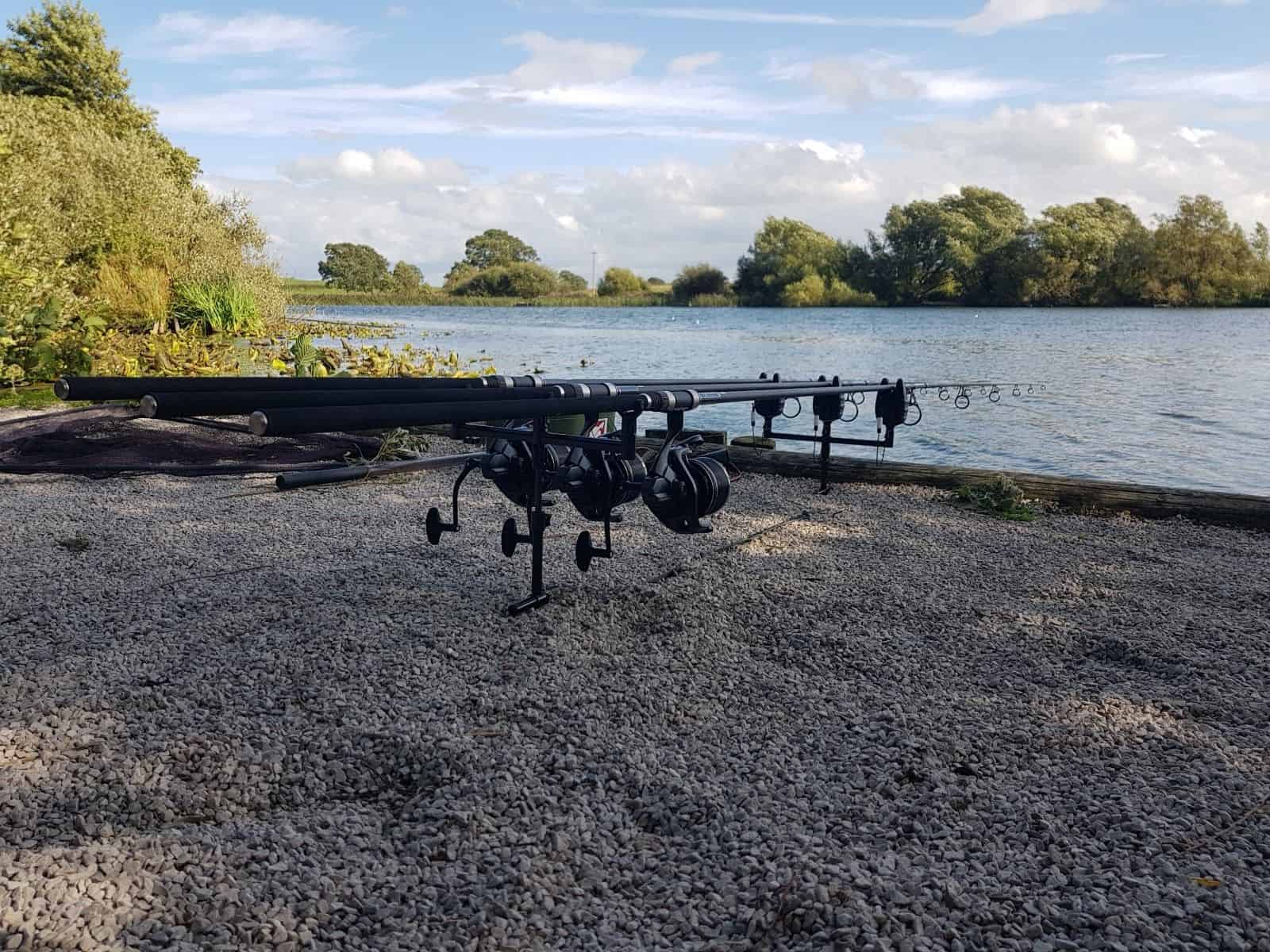What Is Method Feeder Fishing?
The method feeder is a simple device designed to make catching fish as easy as possible. It is mostly used in match fishing.
It delivers a tiny little parcel of bait, which is presented well anywhere you can cast. There is also has a lead built-in, giving itself hooking properties, so you can cast the method feeder anywhere.
As long as there is fish nearby, it’s likely to help you catch some fish.
Predominantly, pellets are used as bait on the method feeder, but also ground bait.
Unfortunately, ground bait is sometimes banned from certain lakes, so I would just use micro pellets with a whole host of different hook baits to draw in the fish.
For most of my method feeder fishing, I use a 6-mm robin red, or halibut pellet banded on the hook, but we could be using maggots, meat, or even mini boilies.
When using the method feeder, it’s important to find a hook bait that pulls the fish towards your hook.
Changing your method feeder bait and hook bait on a regular basis may be the difference between one or two fish, to a lot of fish.
By using a quick-change bead such as this one from NEWSHOT, you can quickly swap to a different bait in a matter of seconds to try and find a bait that interests the fish.
How To Use A Method Feeder
A method feeder acts like an inline lead but gives you the ability to add bait to the method feeder. The main line is threaded through the method feeder and tied to a swivel.
The rig is attached to the swivel and a hook bait is added to the rig, and once the ground bait or pellet is added to the method feeder, the rig is ready to cast out.
The idea behind the method feeder is to feed up your swim by continually casting your rig to a few different spots in your swim.
When the rig is cast out, most anglers will catapult free bait over the rigs to draw the fish in. If the swim goes quiet, the rig is wound in, more pellet or ground bait added to it, and then cast back out.
By using the mold, you are left with a perfectly loaded feeder every time, which makes every single cast as accurate as possible.
Because the feeder is aerodynamic and you’ve also got the same amount of pellets on the feeder every time, in theory, it should be landing in the same place every time.
It’s very important to make sure you sink your line as quickly as possible as it just helps your bite detection.
You don’t want a huge amount of pressure on the tip of your rod. Having a tight line is more likely going to spook fish. It will rise up higher and also dislodge the feeder.
You want to keep the line as slack as possible, but still have a bend in the tip. A soft tip on the rod helps this, and the great thing about the method feeder is it leaves your hands free to be preparing your bait for your next bite or tying rigs.
To connect the line to the hook length, it is preferable to use a quick bead. A very good device it keeps it nice, neat, and tidy at the business end.
It’s a two-part device that opens up and stops the feeder from sliding onto the hook length,
Finally, there’s no need for a light line for method feeder fishing, and an 8-pound or 10-pound line is perfect.
I go for an 8-pound line just because it allows me to sink the line attached quicker and you are ready for a bite.
Another top tip for increasing the attraction around your feeder is with the new Korda goo’s that are now available.
This simply gets squeezed onto the method ball after it’s been formed and out of the mold. Soaking goo into your hook baits also increases the scent trail for fish finding the bait.
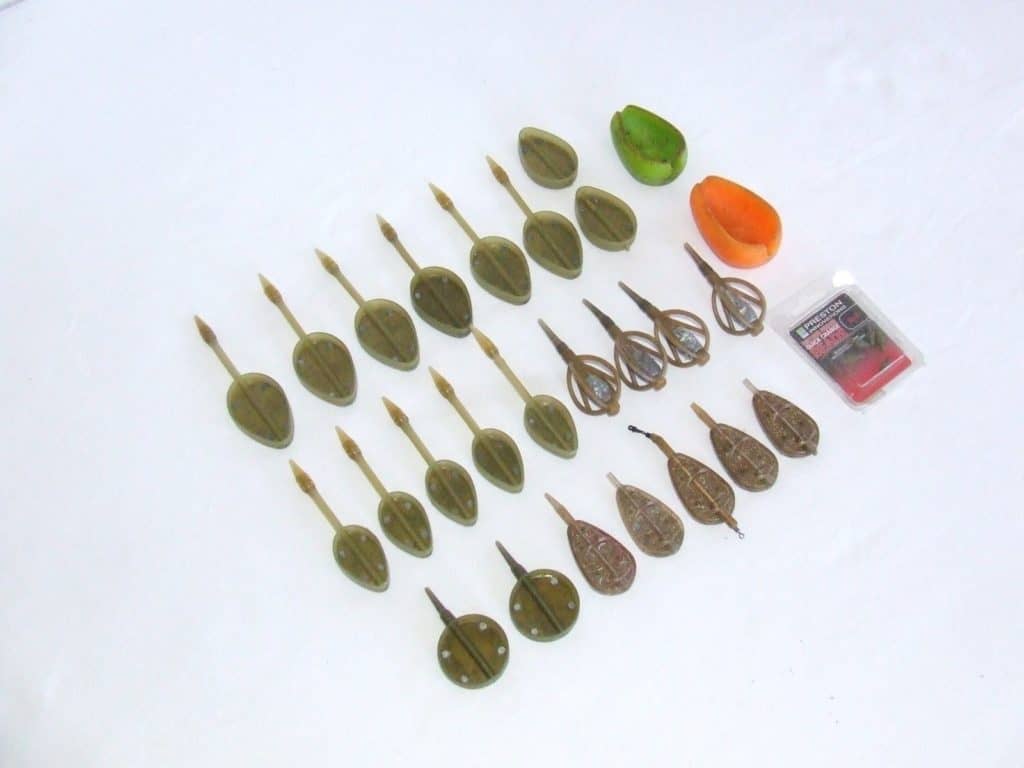
How To Set Up a Method Feeder
- Get the right consistency – Whether you are using micro pellets or ground bait on your method feeder, getting the right consistency is key. 2mm pellets are great for this. The reason is you want the bait to be soggy, but not saturated and sticky. Put the bait into a bucket, and slowly put water in little by little to wet the bait up. Add a small amount of water so there is just enough water to wet the power or pellet, mix it in, then add a little more, mix it in… keep going until you get the right consistency. It is clear when you have the right consistency, just should be able to mold the bait into a ball, without it sticking to your hands. Once it is in a ball, when you squeeze the ball, it should break apart cleanly, again without sticking to your hands. If you manage to get the mix wrong and it becomes too wet, add more powder or pellets to make it dry again, then repeat the process again. Using a riddler to put air into the ground bait will help it to break up when it is cast into the water.
- Prepare your hook bait – Soaking your hook bait in a liquid attractant will help draw in the fish and hopefully trigger a quick bite. If you are using a particle, make sure it has been boiled. But, you could use pellets, boilies, particles or plastic baits. You don’t need big baits when fishing the method feeder, you want a bait big enough to catch the fish’s attention.
- Set up the end tackle – The method feeder is a really simple setup to use. The mainline feeds through the method feeder to a swivel or quick change bead, the hair rig is then clipped onto the quick change bead or swivel. Just add a hook bait, and the ground bait to the method feeder, then you are ready to go.
- Tie your method feeder rig – The method feeder rig is simply a short hair rig. No complexities, just a three to four-inch hair rig with a loop at one end and short hair tied with a knotless knot.
- Pick your spot and feed up the swim – When you are looking for a swim to fish, make sure there is carp in the swim first and foremost, but also make sure there are a few features to fish to so you have choices whilst you are fishing. As you are fishing, keep feeding each of the spots to draw the carp in and keep them interested. You will feed the swim up as you are casting in the method feeder, but also offer free bait by catapulting or throwing particles or boilies onto the spots you are fishing.
There are four main types of feeders, but each of them does a similar job.
- Banjo feeder
- Method feeder
- Maggot feeder
- Cage feeder
The banjo feeder and the flat method feeder are very similar in terms of how they work and how they are loaded.
Banjo Feeder Setup
The banjo feeder is an inline feeder and has two main components, the feeder itself as you can see in the photo below, and the mold to mold the bait and encapsulate the hook bait.
Banjo feeders are available in different sizes and some models are interchangeable without having to untie the rig.
They are a very neat solution to getting the bait into the swim and presented well ready for the fish to find it. Bait is then topped up using one of these, to draw the fish into your swim.
They are best suited with micropellet. Micropellet, when used with the banjo feeder will swell up when it takes on water and spill over the sides, masking the feeder and presenting the rig ready for a passing fish.
Rigs such as the Guru QM1 (as can be seen here) are perfectly suited for all of the feeders on the market today.
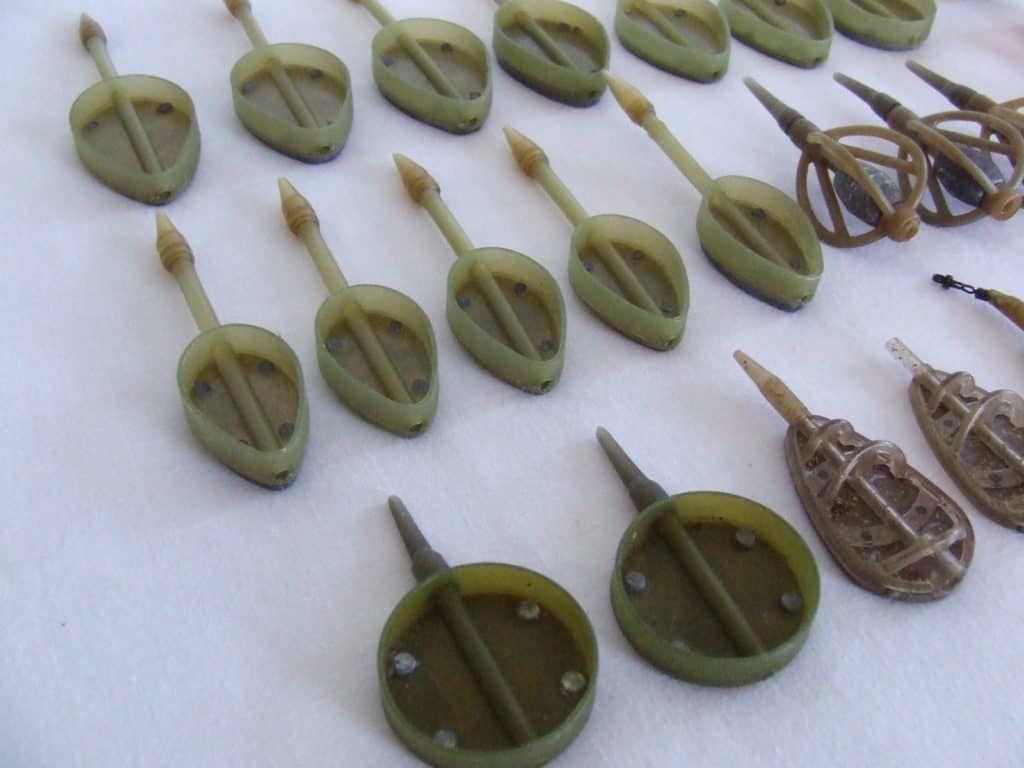
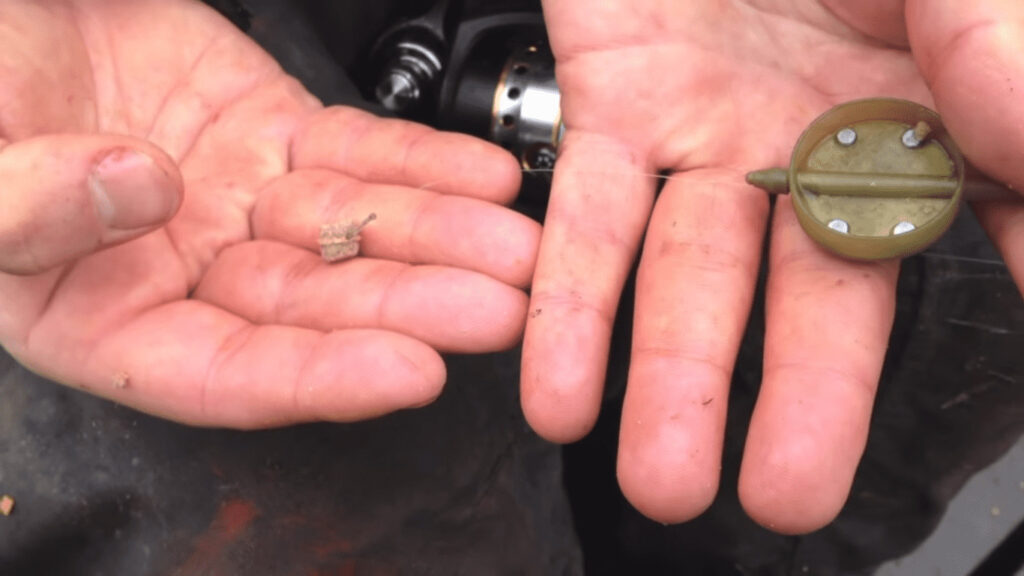
Method Feeder Rig
Method feeders come in various shapes and sizes and are the most popular choice when it comes to feeder fishing. Having method feeders in your fishing tackle may be the key to a quick bite on a quiet day.
The main styles are the flat method feeder and the three-bladed feeder. There is also the spring feeder and the pellet feeder, but I don’t tend to use those.
The flat method feeder is very similar to the banjo feeder above in terms of having a feeder with a lead attached, and a mold, to mold the bait onto the feeder.
The three-bladed feeder is what I started with all those years ago. It is used mainly with ground bait and particles such as hemp. The ground bait is mixed to a certain consistency and pressed by hand onto the mold, then cast out.
The pressing of the bait happens in two stages. The first layer is pressed onto the mold, the hook bait is then pushed into that layer of bait, then the second layer of ground bait is pushed onto the mold to encapsulate the hook bait.
The whole thing is then cast into the swim, then, once the ground bait breaks down, the hook bait and hook are released, ready and waiting for the fish to find it.
The downside to the three-blade method feeder is that it can make quite a splash when casting out, and can weigh a lot, so you have to be careful if you are casting it out a long way.
Make sure your line, rods, and reels are up to the job before casting out.
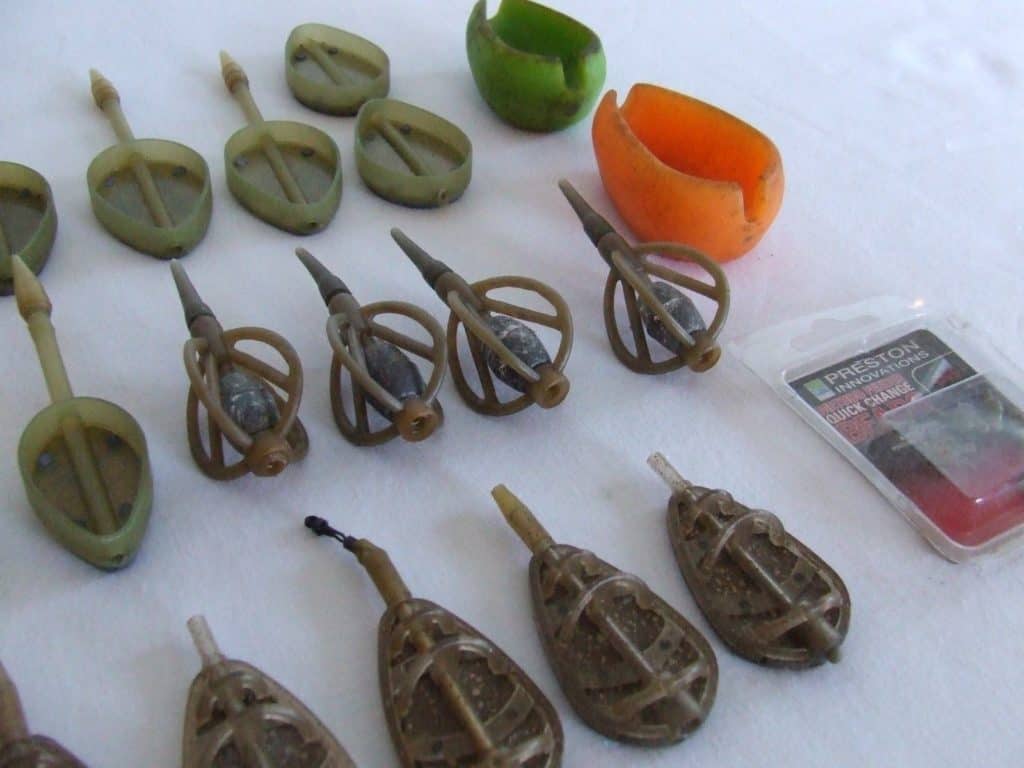
Maggot Feeder Rigs
Maggot feeder rigs are solely used to put maggots accurately in the swim and slowly release them as time passes. The maggots are put into the feeder and capped off with ground bait.
Over time the ground bait breaks down and falls away, releasing the maggots into the swim, to attract the carp toward the rig.
To introduce extra attraction, ground bait balls can be catapulted out, filled with maggots, or thrown out towards the splash of the rig.
These also come in many different sizes and shapes to suit your style of fishing, dependent on how much you want to put into the swim.
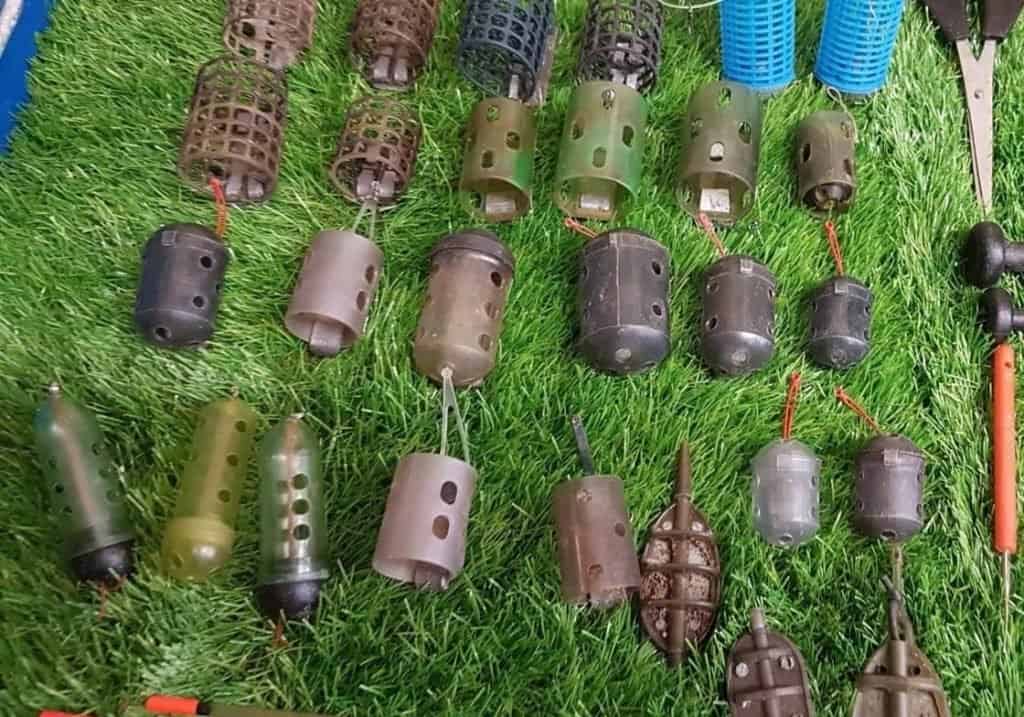
Cage Feeder Rigs
Cage feeder rigs can be used for maggots and bloodworms, but also with pellets and ground bait. It is an effective method of getting bait into your swim quickly.
Again, I would follow the cast with a few catapults of free bait to get the fish grubbing around near your rig.
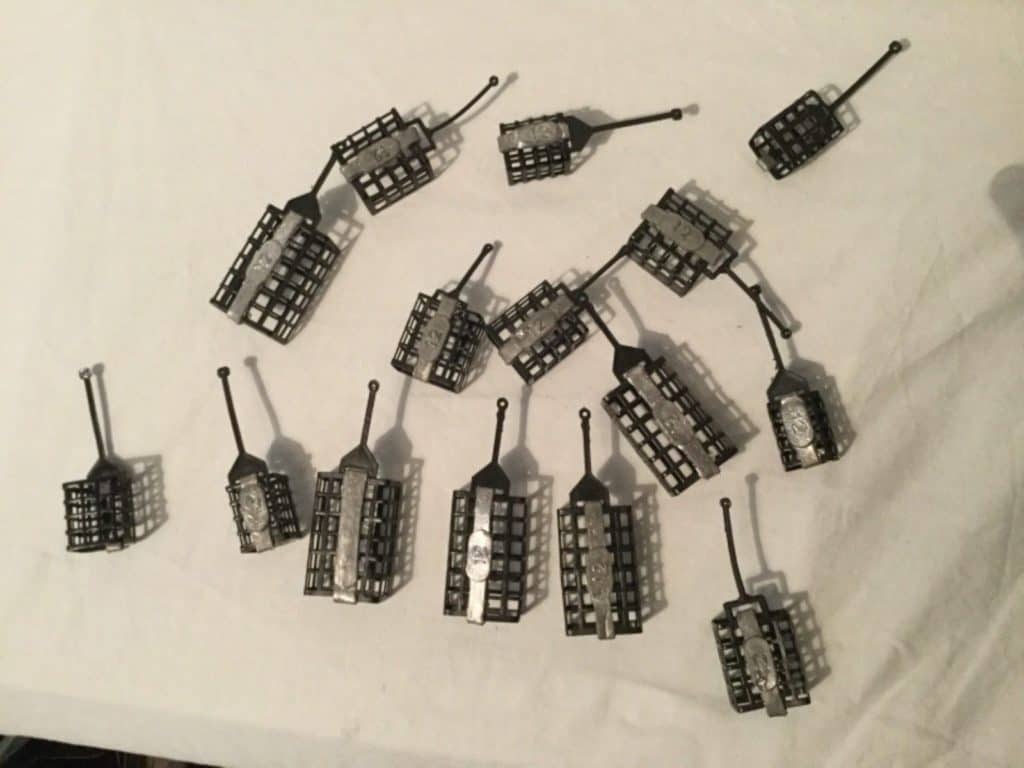
Carp Method Feeder Rigs
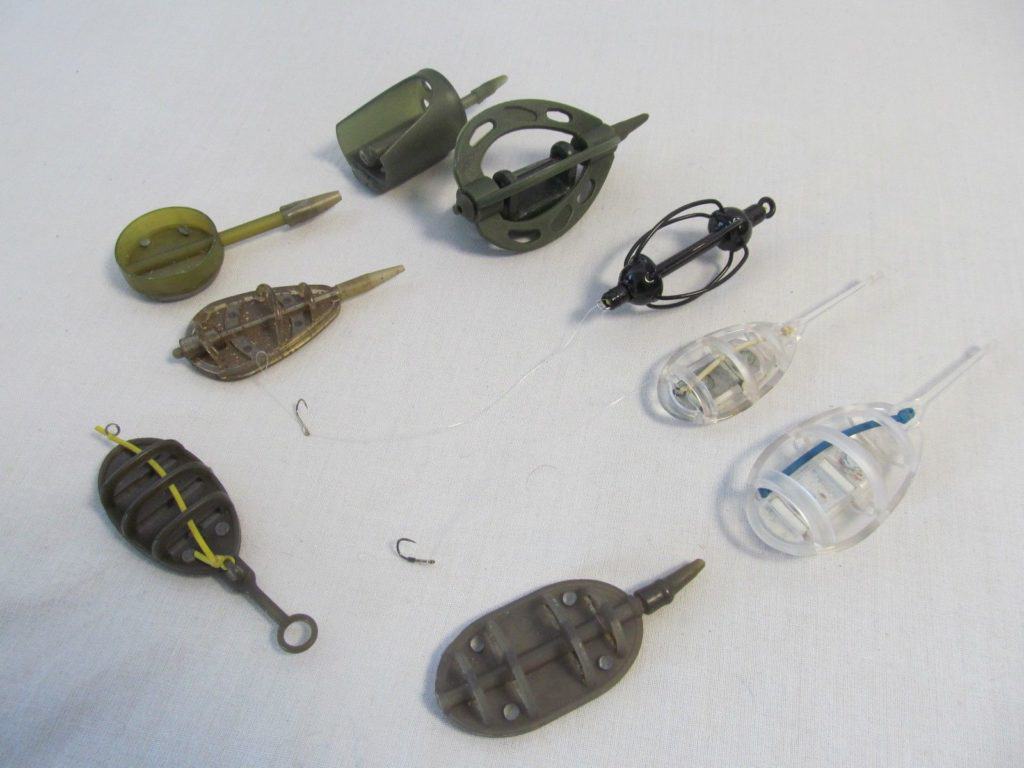
How To Tie Feeder Fishing Rigs
Typically, the fancy rigs you will see on Korda TV aren’t needed here. Most of the rigs you will see attached to a method feeder are very simple and usually have minimal rig components attached if any.
In most of the rigs I use when fishing a method feeder, will be between 2-4-inches, with a hook sized between 14-10. I will use braid at times, but mainly monofilament fishing line. It will be tied with a knotless knot and have shrink tubing to cover the knot and keep everything neat.
The only components I will typically adjust are the style of the rig on the hook and the length of the hair.
I will either fish it with a blowback ring if I am fishing with small boilies, or I will fish the rig with shrink tubing further up the shank to stop the hair tangling if I am fishing with a pellet or particle.
It is very rare that the rig will tangle when fishing the method feeder because the rig is encapsulated inside the bait. But if the bait breaks up and the fish misses the rig, I know it won’t tangle and it will be ready for the next fish.
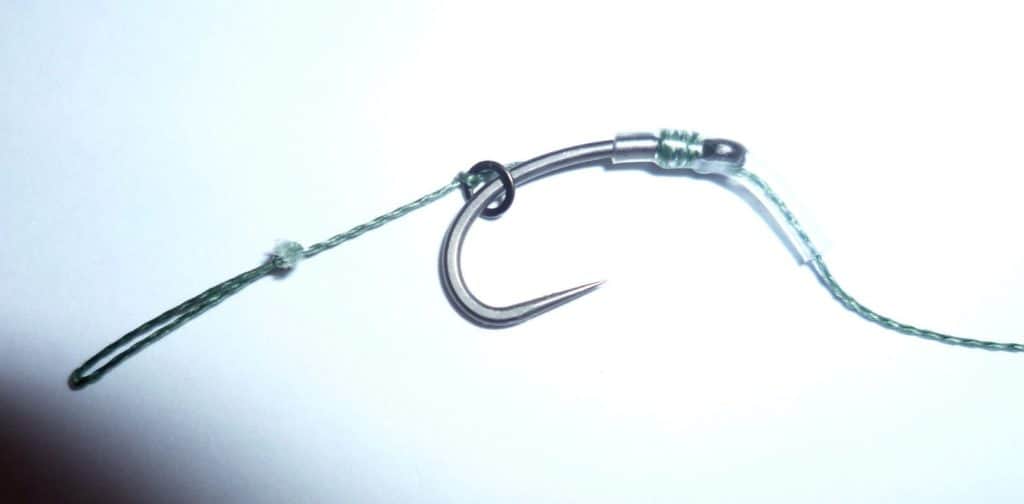
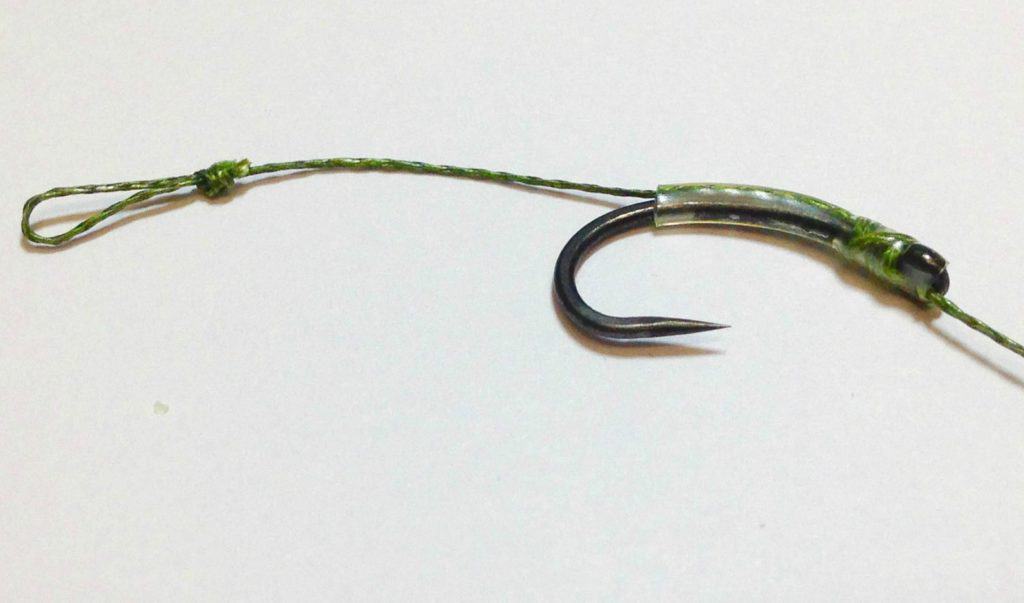
Method Feeder Baits
My go-to bait when method feeder fishing is the Sticky Vortex range, I have tons of confidence in this bait as I have caught bags and bags of fish with it.
I use two different sizes of pellets and add ground bait when I want a bit more attraction in the swim.
The key to method feeder fishing is getting the correct consistency from the ground bait and/or pellet. If you get the consistency wrong, you will get lots of liners from the small fish trying to break with bait up.
You want the bait to swell up and break away, covering the method feeder. If you get this right, you will be able to cast this rig practically anywhere and it will be presented correctly… Even of weed!
Mixing in very small particles such as hemp and crushed snail shells with help add attraction to the bait, but don’t add large particles else the mix won’t swell up and act the way it needs to.
I have tried adding sweetcorn to the mix before and it managed to mask the hook point, so I no longer do it.
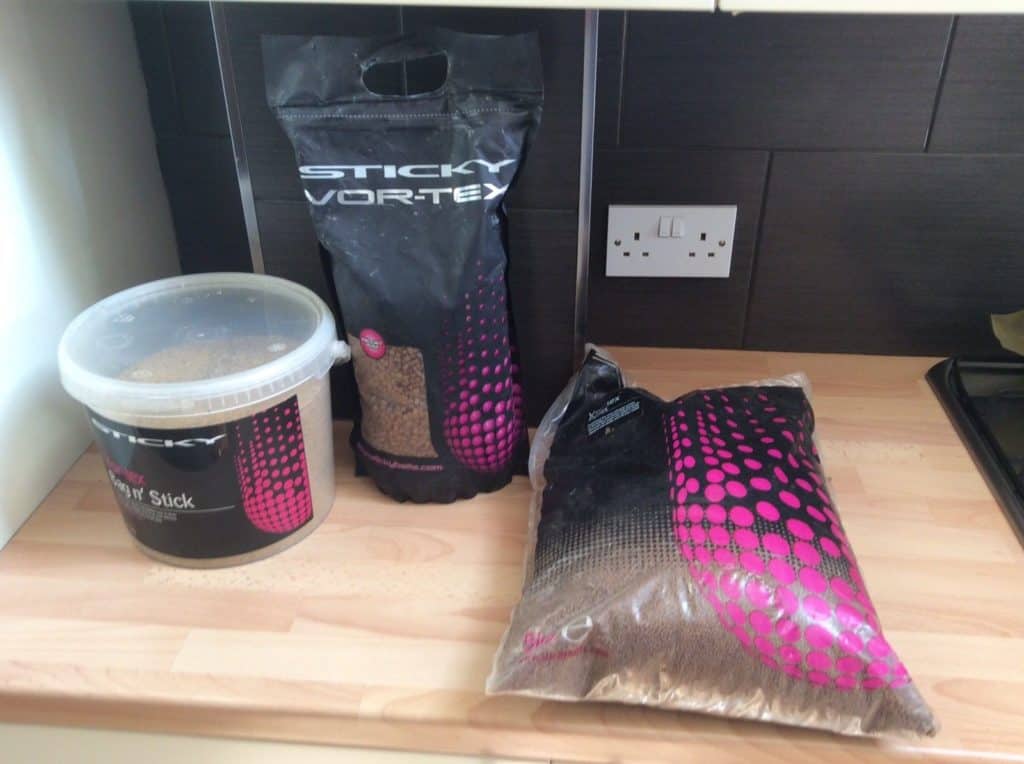
Best Pellets For Method Feeder
Using a range of different sizes when method feeder fishing will keep the fish guessing. The smaller pellets will fall in between the gravel and keep the attraction in your swim, well after the bait has been eaten.
Micro pellets are the key here, they need to take on enough water to create a sticky consistency, but shouldn’t be too hard else they won’t stick together.
Larger pellets will just fall off on the cast, spreading bait over your swim, which will cause the fish to swim over your lines looking for the bait.
Instead, you need tight little feeding spots, just enough to tempt the fish in for a cheeky bite, then come back for more once your next offering is in place.
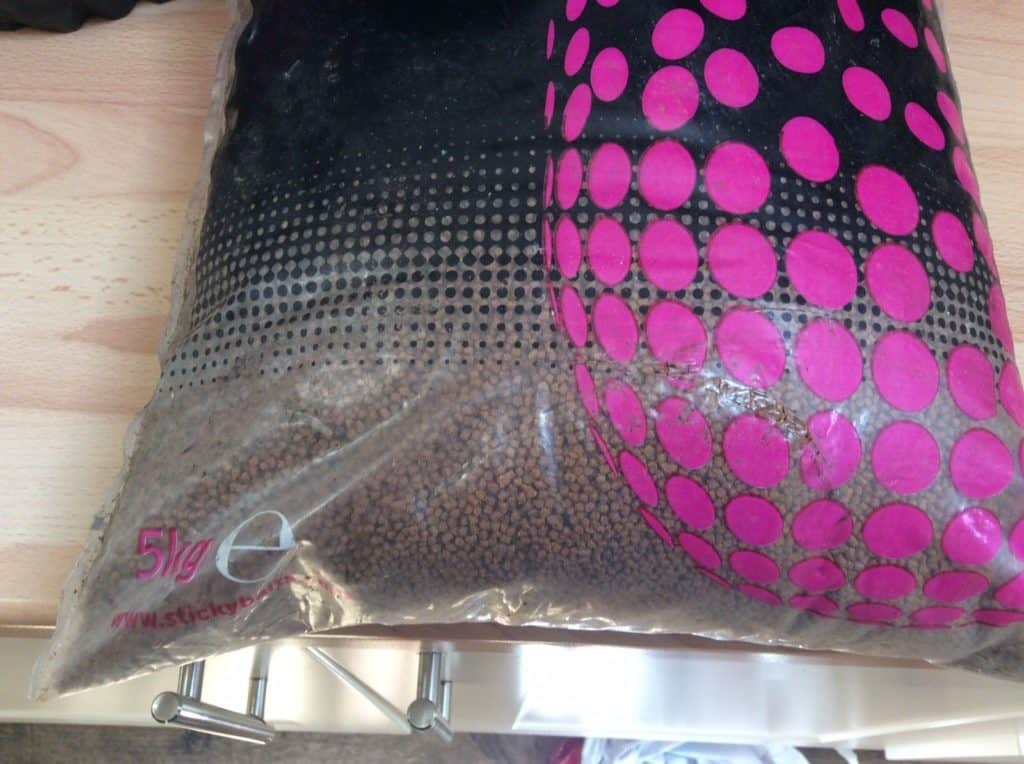
Best Ground Bait For Carp
I try to match my ground bait to my pellets and then add other attractants will liquids and fish oils.
As you can see from the photo below, this ground bait has lots of different-sized particles in it. Some of these will rise through the layers of water, drawing the fish into your method feeder setup.
Adding fish oil and goo will also draw the fish in from the extra added attraction.
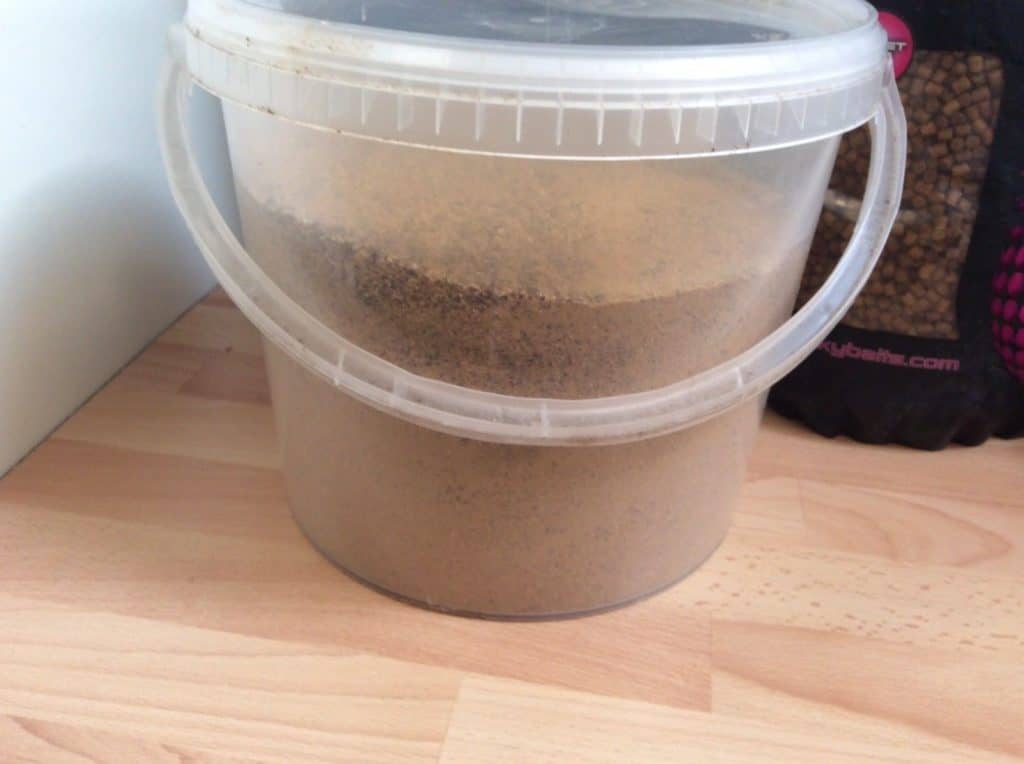
Best Hook Bait For Method Feeder
The hook bait is another key part of this type of fishing but is it also one that you should be constantly changing to find something that catches the fish’s eye when they feed on the pellet or ground bait.
Pellets such as 8mm halibut pellets and meat such as pepperami have worked really well for me. But bright baits such as boilies and imitation plastic baits have caught most of my fish.
Soaking the boilies in liquid attractants will help target the fish onto your hook bait, but try not to soak the hook bait pellet too much else it will turn to mush and fall off, leaving you wondering why you aren’t catching any fish.
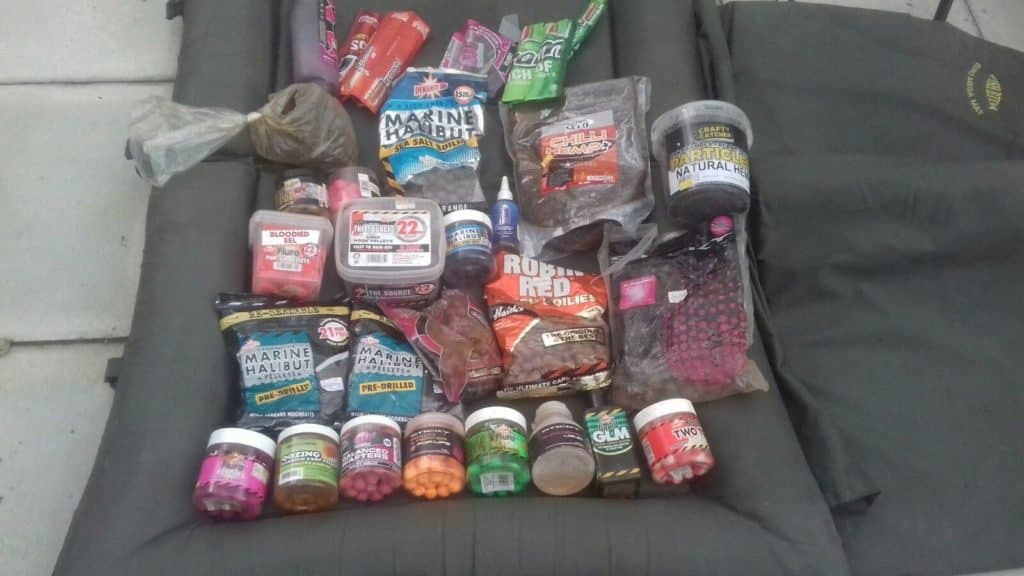
Further Reading
I have made a lot of mistakes during my fishing sessions and don’t want you to make the same mistakes. I’ve learned the hard way over 20 years of fishing most weekends, testing, tweaking, and testing again and now want to help you excel with your carp fishing.
If you need any help, you can reach me at Fishing Again’s Facebook page
Last Updated on February 5, 2024 by Shane

